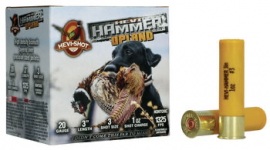Joe Hunter
Active member
Munster -- Here's some info on your topic that may be of interest.
20ga lead and steel pheasant loads
If you are shooting pheasants with a 20-gauge, go with 2 ¾-inch 1-ounce or 3-inch 1 1/4-ounce loads with lead #6s or #5s. Choked appropriately, those loads should take care of any pheasant shooting out to about 40 yards, if you can put the pattern on the front end of the bird!
Here are a few of my pattern numbers to give you an idea of how my pheasant reloads perform in my gun.
Patterns from a 20-gauge Browning Citori with 28" Invector-plus barrels and Briley flush chokes (patterns average of five, 30" post-shot scribed circle, yardage taped muzzle to target, and in-shell pellet count average of five).
20 GA 2 ¾” RELOAD (BLUE DOT)
1 oz #6 lead (233 pellets) @ 1200 fps
30 YARDS – SK / pattern 147 (63%)
30 YARDS – IC / pattern 168 (72%)
40 YARDS – M / pattern 146 (63%)
40 YARDS – IM / pattern 163 (70%)
20 GA 3" RELOAD (BLUE DOT)
1 1/8 oz #5 lead (190 pellets) @ 1220 fps
30 YARDS – SK / pattern 140 (74%)
30 YARDS – IC / pattern 149 (78%)
40 YARDS – M / pattern 138 (73%)
40 YARDS – IM / pattern 147 (77%)
If you need or choose to shoot 20-gauge steel loads at pheasant, go with 3-inch 1-ounce loads of either #3 or #2 steel. Steel shot lethality research on pheasants conducted by Tom Roster showed #2 steel to be more effective (at all ranges) than either #6 or #4 steel. Yes, you can kill pheasants with #4 or #6 steel loads, but a little extra pellet energy is a good thing on wild pheasants where shots tend to be going-away and can get on the long side. The research also showed #2 steel resulted in fewer cripples than both #6 and #4 steel; and Roster also speculated that the #3 steel pellet would be a good compromise between pellet count and downrange energy.
Here are a few of my pattern numbers to give you an idea of how these loads perform in my gun.
Pattern numbers from a 20-gauge Browning Citori with 28" Invector-plus barrels and Briley flush chokes (patterns average of five, 30" post-shot scribed circle, yardage taped muzzle to target, and in-shell pellet count average of five).
20 GA 3" WINCHESTER DRYLOK SUPER-X STEEL LOAD
1 oz #3 steel (145 pellets) @ 1330 fps
30 YARDS – SK / pattern 114 (78%)
30 YARDS – IC / pattern 123 (85%)
40 YARDS – IM / pattern 106 (73%)
40 YARDS – LF / pattern 110 (76%)
20 GA 3" REMINGTON NITRO-STEEL MAGNUM LOAD
1 oz #2 steel (118 pellets) @ 1330 fps
30 YARDS – SK / pattern 101 (86%)
30 YARDS – IC / pattern 105 (89%)
40 YARDS – IM / pattern 99 (84%)
40 YARDS – LF / pattern 102 (86%)
Good luck!
20ga lead and steel pheasant loads
If you are shooting pheasants with a 20-gauge, go with 2 ¾-inch 1-ounce or 3-inch 1 1/4-ounce loads with lead #6s or #5s. Choked appropriately, those loads should take care of any pheasant shooting out to about 40 yards, if you can put the pattern on the front end of the bird!
Here are a few of my pattern numbers to give you an idea of how my pheasant reloads perform in my gun.
Patterns from a 20-gauge Browning Citori with 28" Invector-plus barrels and Briley flush chokes (patterns average of five, 30" post-shot scribed circle, yardage taped muzzle to target, and in-shell pellet count average of five).
20 GA 2 ¾” RELOAD (BLUE DOT)
1 oz #6 lead (233 pellets) @ 1200 fps
30 YARDS – SK / pattern 147 (63%)
30 YARDS – IC / pattern 168 (72%)
40 YARDS – M / pattern 146 (63%)
40 YARDS – IM / pattern 163 (70%)
20 GA 3" RELOAD (BLUE DOT)
1 1/8 oz #5 lead (190 pellets) @ 1220 fps
30 YARDS – SK / pattern 140 (74%)
30 YARDS – IC / pattern 149 (78%)
40 YARDS – M / pattern 138 (73%)
40 YARDS – IM / pattern 147 (77%)
If you need or choose to shoot 20-gauge steel loads at pheasant, go with 3-inch 1-ounce loads of either #3 or #2 steel. Steel shot lethality research on pheasants conducted by Tom Roster showed #2 steel to be more effective (at all ranges) than either #6 or #4 steel. Yes, you can kill pheasants with #4 or #6 steel loads, but a little extra pellet energy is a good thing on wild pheasants where shots tend to be going-away and can get on the long side. The research also showed #2 steel resulted in fewer cripples than both #6 and #4 steel; and Roster also speculated that the #3 steel pellet would be a good compromise between pellet count and downrange energy.
Here are a few of my pattern numbers to give you an idea of how these loads perform in my gun.
Pattern numbers from a 20-gauge Browning Citori with 28" Invector-plus barrels and Briley flush chokes (patterns average of five, 30" post-shot scribed circle, yardage taped muzzle to target, and in-shell pellet count average of five).
20 GA 3" WINCHESTER DRYLOK SUPER-X STEEL LOAD
1 oz #3 steel (145 pellets) @ 1330 fps
30 YARDS – SK / pattern 114 (78%)
30 YARDS – IC / pattern 123 (85%)
40 YARDS – IM / pattern 106 (73%)
40 YARDS – LF / pattern 110 (76%)
20 GA 3" REMINGTON NITRO-STEEL MAGNUM LOAD
1 oz #2 steel (118 pellets) @ 1330 fps
30 YARDS – SK / pattern 101 (86%)
30 YARDS – IC / pattern 105 (89%)
40 YARDS – IM / pattern 99 (84%)
40 YARDS – LF / pattern 102 (86%)
Good luck!

